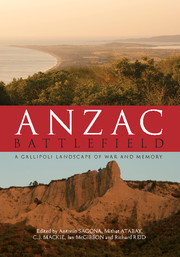Book contents
- Frontmatter
- Foreword
- Contents
- Figures
- Plates
- Contributors
- Acknowledgements
- Abbreviations
- Gallipoli battlefield place names
- Introduction
- 1 Boundary and divide: The antiquity of the Dardanelles
- 2 The Gallipoli campaign: History and legend
- 3 Recording the battlefield: First steps
- 4 Capturing the battlefield: Mapping and air photography at Gallipoli
- 5 Battlefield archaeology: Gallipoli
- 6 Forming the ANZAC battlefield
- 7 Forming the Ottoman battlefield
- 8 Artefacts from the battlefield
- 9 Remembering Gallipoli
- 10 Remembering Gallipoli from a Turkish perspective
- Conclusion
- Appendix Anzac Gallipoli Archaeological Database
- References
- Index
3 - Recording the battlefield: First steps
Published online by Cambridge University Press: 05 December 2015
- Frontmatter
- Foreword
- Contents
- Figures
- Plates
- Contributors
- Acknowledgements
- Abbreviations
- Gallipoli battlefield place names
- Introduction
- 1 Boundary and divide: The antiquity of the Dardanelles
- 2 The Gallipoli campaign: History and legend
- 3 Recording the battlefield: First steps
- 4 Capturing the battlefield: Mapping and air photography at Gallipoli
- 5 Battlefield archaeology: Gallipoli
- 6 Forming the ANZAC battlefield
- 7 Forming the Ottoman battlefield
- 8 Artefacts from the battlefield
- 9 Remembering Gallipoli
- 10 Remembering Gallipoli from a Turkish perspective
- Conclusion
- Appendix Anzac Gallipoli Archaeological Database
- References
- Index
Summary
Two of the most important sources for understanding what the Anzac battlefield looked like shortly after the campaign are the maps produced by the Turkish cartographer Mehmet Şevki Pasha and the material collected in 1919 by the Australian Historical Mission and the Australian War Records Section. Şevki Pasha's detailed maps, produced in the immediate aftermath of the Allied evacuation of December 1915, are an invaluable source, allowing for detailed comparison between the recently deserted Turkish and Allied trenches and what has survived today. Indeed, without these maps, verifying the modern recording of the old trench positions would be much more difficult. The diaries, sketches, maps, drawings and photographs produced by the Australian Historical Mission in 1919 created a large collection still to be fully exploited in modern interpretations of the battlefield landscape.
In the JHAS encounter with the modern terrain of ‘old Anzac’, it was important to understand something of the workings of these first efforts to document that landscape. It became evident, for example, that Şevki Pasha had not recorded everything. There were surviving trench lines that he, and his aides, either did not consider worth mapping or were unable to record in the time they had available. Similarly, it was well outside the remit of the Australian Historical Mission to make detailed note of trench lines and other key positions. That said, the Turkish maps and the Mission's collections could well be valuable starting points for further archaeological and historical investigation of the battlefield features surviving at Gallipoli today. They would certainly, if used imaginatively, enhance efforts at modern site interpretation.
AUSTRALIAN HISTORICAL MISSION, FEBRUARY–MARCH 1919
Charles Bean spent virtually the whole of the 1915 campaign at Gallipoli as Australia's official war correspondent. On Saturday 15 February 1919, now the nation's official historian, he returned to Anzac: ‘… my heart bounded … the place seemed to have been abandoned only yesterday.’ Bean observed that the eastern slopes of Second Ridge were still crowded with the excavated terraces where the Ottoman soldiers had lived; saw that a maze of trenches still led up to the front line on the Lone Pine plateau; and experienced again, as he went along Second Ridge, how close to each other the Ottoman and Anzac trenches had been.
- Type
- Chapter
- Information
- Anzac BattlefieldA Gallipoli Landscape of War and Memory, pp. 36 - 58Publisher: Cambridge University PressPrint publication year: 2016



